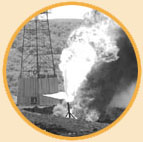Hell's Half-Acre
 The enormous
waste of natural gas was a dubious distinction that Turner Valley claimed for
many years. This problem occurred due to the common practice of passing the gas
through separators, then flaring it off. The producers flared the by-product gas
after producing the oil. This had greatly reduced the pressure on the oil reservoir, reducing the amount of recoverable oil. As a result, the Turner
Valley field realized only a portion of its oil potential. The enormous
waste of natural gas was a dubious distinction that Turner Valley claimed for
many years. This problem occurred due to the common practice of passing the gas
through separators, then flaring it off. The producers flared the by-product gas
after producing the oil. This had greatly reduced the pressure on the oil reservoir, reducing the amount of recoverable oil. As a result, the Turner
Valley field realized only a portion of its oil potential.
But the size of
the problem was not clear until the oil column was later discovered. The flares
were visible in the sky for miles around. Many of these were in a small ravine
known to locals as Hell's Half-Acre. Because of the presence of the flares, the
grass stayed green year-round, local hunters hunted with the artificial light
and migrating birds wintered in their warmth. By the 1930s, the Depression would
worsen the economic situation in Canada and as a result, drilling at Turner
Valley ground to a halt.
  |
|
 Heritage Community Foundation Presents
Heritage Community Foundation Presents





